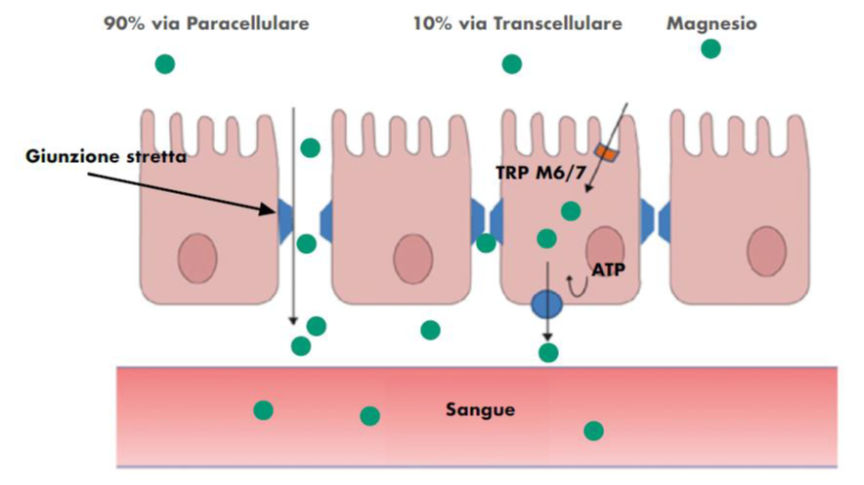Our body’s absorption of magnesium

Magnesium is an essential mineral to maintain a healthy balance in our body, and is present in quantities varying from 22 g to 26 g. Of this quantity, more than 50% is mineralised in the bones. In fact, the skeleton is the main storage area for our reserves of magnesium, but its absorption is actually via our intestines and is influenced by various factors. Let’s look at them in more detail.
The functions of magnesium
In our organism, magnesium is a co-factor for more than 300 enzymes and is therefore involved in a great number of processes, from the synthesis of neurotransmitters essential in our central nervous system, to the production and release of cell energy. What’s more, as magnesium acts in balance with calcium, also contributing to the control of fundamental processes such as muscular contractions, heartbeat, coagulation and blood pressure.
This mineral is essential to our health as it contributes:
- to normal energy-yielding metabolism;
- to normal functioning of the nervous system;
- to a reduction of tiredness and fatigue, facilitating muscle relaxation;
- to normal psychological function;
- to the maintenance of normal bones and teeth;
- to keeping normal electrolyte balance.
Magnesium deficiency is a common condition, above all among women, and signs often include cramps, physical and mental fatigue, irritability and insomnia.
To supplement the natural reserves of this mineral, we should follow a healthy and balanced diet, which includes approx. 300 g of magnesium (recommended daily dose). Our ally in this case is food rich in magnesium, such as green leafed vegetables, legumes, cereals, bananas and dried fruit (almonds and peanuts above all). Not forgetting, also, the contribution of water, which alone contains 10% of the quantity of magnesium required by our body each day.
How does magnesium absorption work?
Magnesium is mainly absorbed via the small bowel, in particular in the jejunum and the ileum sections, and in a low percentage via the large bowel. Of all the quantity of magnesium entering the body through diet, our body is able only to absorb 30-40%.
Absorption involves two different mechanisms: one passive and one active Passive absorption depends on the gradient of concentration established between the intestine and blood circulation. This type of absorption is paracellular, via the tight junctions between the enterocytes (Figure 1).
 Figure 1. Types of magnesium absorption.
Figure 1. Types of magnesium absorption.
The other magnesium absorption mechanism is active and is transcellular, exploiting the specific transporters TRPM6/7 (transient receptor potential melastatin 6/7), which transfer the magnesium absorption from the apical to the basolateral side of the enterocyte (i.e. the epithelial cells). This is the point at which magnesium enters the blood stream.
This second absorption process is also known as facilitated diffusion and is a saturable and inducible mechanism. Saturable means that when the magnesium ion exceeds a certain concentration threshold, the carrier protein closes its channel and prevents the transfer of any further quantities. Inducible, on the other hand, means that the carriers can be synthesised and expressed on the cell membrane as needed, in other words when the body detects a deficiency of magnesium and there are not sufficient reserves.
What factors influence the absorption of magnesium?
As already explained, our body is only able to absorb 30-40% of the quantity of magnesium found in food. As well as this limit, there are also other factors that can have a negative influence on this absorption capacity, such as:
- The presence of phytic acid (inositol): inositol significantly limits the absorption of magnesium, because when it binds to magnesium it forms insoluble salts in the stomach, which are impossible to absorb in the intestine.
- Vitamin D deficiency: the intestinal absorption of magnesium is linked to the plasma content of Vitamin D and therefore, the higher its value, the greater the absorption of this mineral.
- High levels of calcium and phosphate: very high contents of calcium ions and phosphate can cause a reduction in magnesium absorption.
Another two important hormones that significantly influence the absorption of magnesium, but this time in a positive way, are parathormone and estrogens.
The relationship between Parathormone (PTH) and magnesium is mechanical, and in fact when the serum concentration of magnesium is high, the production of PTH by the parathyroids is reduced; on the other hand, when the concentration of magnesium falls below the threshold value, the parathyroids are stimulated to secrete PTH, which thereby increases the re-absorption of magnesium by the proximal convoluted tubule, and also the absorption of the mineral in the intestine.
Meanwhile the estrogens increase intestinal absorption of magnesium and its renal re-absorption. For this reason, the physiological decrease in these hormones – typically during menopause – exposes women more to the risk of developing osteoporosis.
How can magnesium absorption be increased?
When diet alone is not enough to maintain our body’s demands or when there is an increase in need, magnesium supplements may be useful. However, not all commercially available supplements contain the same type of magnesium and this is the essential difference.
Magnesium can be found in the form of various salts:
- inorganic, such as magnesium oxide;
- organic, such as magnesium pidolate;
- chelated, such as magnesium bisglycinate.
Among these, magnesium oxide (MgO) is undoubtedly the one with the highest content of elementary magnesium, although absorption by the body is very limited. To overcome these limits, thanks to research by PharmaNutra, UltraMag® has been developed, a nutrition supplement based on magnesium oxide that exploits the Sucrosomial® Technology, a delivery system in which the mineral is carried by the Sucrosoma®, a matrix consisting of phospholipids and sugar fatty acid esters (sucrose esters). This structure enables the absorption of greater quantities of magnesium by our body, without blocking its normal route of absorption.
The dose of magnesium oxide in UltraMag® is 375 mg, which corresponds to 100% of the Nutrient Reference Values (NRV). For this reason we recommend taking one sachet a day dissolved in a glass of water, at any time of the day
integratori magnesio minerali ricerca scientifica salute sucrosomiale
